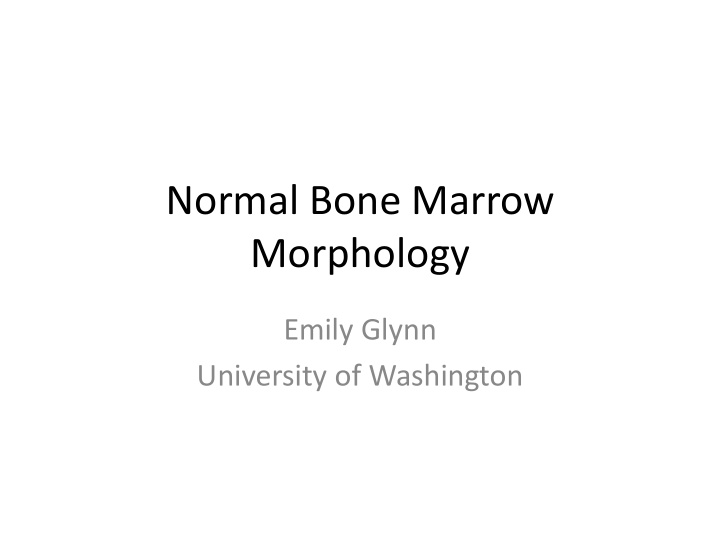



Normal Bone Marrow Morphology Emily Glynn University of Washington
Components of a Bone Marrow Study 1. Peripheral Blood 2. Aspirate smears or touch preparations 3. Core/Trephine biopsy Malempati S. N Engl J Med 2009;361:e28 .
1 - Peripheral Blood • Wright-stained slides prepared from a smeared drop of peripheral blood • Used for the assessment of: – Cytopenias or cytoses – Leukocyte distribution and morphology – RBC and platelet morphology – Abnormal populations (e.g. circulating blasts or other atypical cells) https://en.wikipedia.org/wiki/Blood_film
Feathered Edge A good place to looks for circulating blasts and atypical cells
2 – Aspirate Smears • Wright-stained cover slips or slides prepared from bone marrow spicules • Used for assessment of: – Study adequacy – Rough estimate of cellularity (hypo-, normo-, hyper-) – Presence of trilineage hematopoiesis and maturation • Myeloids, erythroids, and megakaryocytes – Morphology – Enumeration • Myeloids, erythroids, lymphocytes, plasma cells, blasts • Myeloid to erythroid ratio – Abnormal populations • Assessment of storage iron and ring sideroblasts should be reserved for the aspirate
Malempati S. N Engl J Med 2009;361:e28 .
Low Power • Adequacy • Cellularity • Megakaryocyte morphology Megakaryocytes Spicules
Medium - High Power • Myeloid and erythroid maturation • Morphology • Enumeration (high power) • Abnormal populations
2) Basophilic Normoblast 3) Polychromatophilic Normoblast 1) Pronormoblast 4) Orthochromic Normoblast Erythroid Maturation
5) Band 1-2) Blasts / Promyelocyte 3) Myelocyte 2) Promyelocyte 4) Metamyelocyte Myeloid Maturation
Lymphocyte Plasma Cell Miscellaneous
2 – Aspirate Smears Summary • Low Power – Assess study adequacy – Rough estimate of cellularity – Identify megakaryocytes and assess morphology – Overtly abnormal populations • Medium to High Power – Assess myeloid and erythroid maturation and morphology – Enumeration – Identify abnormal populations that are more subtle
3 – Core Biopsy • The bone marrow core is decalcified, fixed in formalin, paraffin-embedded, thinly sectioned and stained with hematoxylin and eosin. • Used for the assessment of: – More precise estimate of cellularity – Marrow architecture – Marrow fibrosis – Abnormal populations that were inaspirable
Bony trabeculae Subcortical zone of hypocellularity Marrow Space An adequate core biopsy should be at least 1.5 cm in length and contain at least 10 inter-trabecular areas
Low Power • Cellularity • Abnormal populations
Medium to High Power • Architecture • More subtle abnormal populations Interstitial Paratrabecular
Megakaryocytes are located adjacent to marrow capillary sinuses, but appear scattered throughout the interstitium
Immature myeloids start paratrabecular and mature into the interstitum
Erythroids cluster together in the interstitum
Questions!
1. Cell type? 2. To what peripheral blood constituent does it give rise?
1. Cell type? Megakaryocyte 2. To what peripheral blood constituent does it give rise? Platelets
A B 1. What is the lineage of cells A, B, and C? C 2. Re-order cells in the correct maturational sequence from least to more mature
A B 1. What is the lineage of cells A, B, and C? Erythroid C 2. Re-order cells in the correct maturational sequence from least to more mature. B, C, A
Cell type?
Cell type? Plasma cell
B A C 1. What is the name of cells A, B, and C? 2. Lineage? 3. Re-order cells in the correct maturational sequence from least to more mature.
A B C 1. What is the name of cells A, B, and C? A – Myelocyte, B – Promyelocyte, C – Metamyelocyte 1. Lineage? Myeloid 1. Re-order cells in the correct maturational sequence from least to more mature. B, A, C
Summary • In general, a bone marrow study is composed of the following complementary components: – Peripheral blood – Aspirate smear/touch preparations – Core biopsy • The three hematopoietic lineages are myeloids, erythroids, and megakaryocytes • Knowledge of normal marrow morphology, distribution, and maturational sequence is important for identifying abnormalities
Questions?
Recommend
More recommend